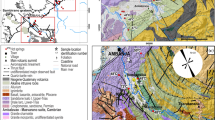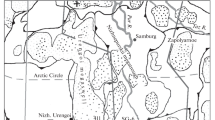Abstract
Thermal conductivity of individual rock types plays a noteworthy role in melting of the ice mass at the contact with the rocks. These are heavily influenced by their mineral constituents and the structural fabrics within the rocks. In the decreasing order of influence on melting of the nearby ice mass, the exposed rock units of Schirmacher Oasis are demarcated as metapelites (6.1 ± 0.37 Wm−1K−1), quartzofeldspathic augen gneiss (6.08 ± 0.04 Wm−1K−1), garnet rich biotite quartzofeldspathic gneiss with rare layers of amphibolites (4.34 ± 0.68 Wm−1K−1), charnockite-enderbite interlayered with pyroxene granulite (3.99 ± 0.44 Wm− 1K−1), quartzofeldspathic gneiss ± garnet with few enclaves of charnockite and pyroxene granulites (3.53 ± 0.22 Wm−1K−1), norite (3.38 ± 0.26 Wm−1K−1), dolerite dykes (3.32 ± 0.15 Wm−1K−1). Metamafic and metaultramafic rocks occurring as enclaves in charnockitic zones (3.07 ± 0.11 Wm−1K−1), nodular basaltic dykes (2.98 ± 0.16 Wm−1K−1) and lamprophyre dykes (2.77 ± 0.18 Wm− 1K−1). The detail investigation around Dakshin Gangotri Glacier snout at the margin of the Schirmacher Oasis and the Polar ice sheet indicates that the rocks with higher thermal conductivity values show a higher average annual recession than that of the lower thermal conductivity values. The spatial distribution and the variations in the thermal conductivity of the rocks in different places within the Schirmacher Oasis are one of the factors contributing to the differential rate of Polar ice sheet recession at its margin.
Similar content being viewed by others
References
Adhikary, S., Nakawo, M., Seko, K. and Shakya, B. (2000) Dust influence on the melting processes of glacier ice: experimental results from Lirung Glacier, Nepal Himalayas. Debris-covered Glaciers, Proceedings of a workshop held at Seattle, Washington, IAHS Publ. no. 264, pp.43–52.
Bose, S. and Sengupta, S. (2003) High Temperature mylonitization of quartzofeldspathic gneisses: Examples from the Schirmacher Hills, East Antarctica. Gondwana Res., v.6(4), pp. 805–816.
Carslaw, H. S. and Jaeger, J. C. (1959) Conduction of heat in solids. 2nd ed. Oxford: Clarendon Press.
Cermak, V. and Rybach, L. (1982) Thermal conductivity and specific heat of minerals and rocks.Landolt-Bornstein; Zahlenwerte und Funktionenaus Naturwissenschaften und Technik, pp.305–343.
Clauser, C. and Huenges, E. (1995) Thermal conductivity of Rocks and Minerals.Rock Physics and Phase Relations.A Handbook of Physical Constants. AGU Reference Shelf 3, pp.45.
Chaturvedi, A., Singh, A., Gaur, M.P., Krishnamurthy, K.V. and Beg, M.J. (1999) A Confirmation of Polar Glacial Recession by monitoring the Snout of Dakshin Gangotri Glacier in Schirmacher range. Scientific report on fifteenth Indian Expedition to Antarctica, Tech. Pub No. 13, Department of Ocean Development, Govt. of India, New Delhi, pp.321–336.
D’Souza, M.J., Roy, S.K. and Swain, A.K. (2011) Detailed study of schirmachermylonites to determine formation time and stress, strain, temperature involved in their formations as an implication to exhumation history. Unpublished report, Antarctica Division (Mission IV), Geol. Surv. India, pp.1–35.
GSI (1998) Geological Map of the Schirmacher Oasis, central Dronning Maud Land, East Antarcica published by Geological Survey of India.
Huang, J.P., Swain, A.K., Thacker, R.W., Ravindra, R., Andersen, D.T. and Bej, A.K. (2013) Bacterial diversity of the rock-water interface in an East Antarctic freshwater ecosystem, Lake Tawani(P). Aquatic Biosystems, v.9(4), pp.1–10.
Ingersioll, L., Zobel, O.J., and Ingersoll, A.C. (1954) Heat Conduction: With Engineering Geological and other applications. Oxford and Ibh Publishing Co., Calcutta; Bombay; New Delhi, pp.15–25.
IPCC (2010) Mastrandrea, M.D., Field, C.B., Stocker, T.F., Edenhofer, O., Ebi, K.L., Frame, D.J., Held, H., Kriegler, E., Mach, K.J., Matschoss, P.R., Plattner, G.K., Yohe, G.W. and Zwiers, F.W. 2010. Guidance Note for Lead Authors of the IPCC Fifth Assessment Report on Consistent Treatment of Uncertainties.Intergovernmental Panel on Climate Change (IPCC). pp.1–7.
Kayastha, R.B., Takeuchi, Y., Nakawo, M. and Ageta, Y. (2000) Practical prediction of ice melting beneath various thickness of debris cover on Khumbu Glacier, Nepal, using a positive degree-day factor. Debris-Covered Glaciers (Proceedings of a workshop held at Seattle, Washington, USA, Sept. 2000). IAHS Publ., no.264, pp.71–81.
Mattson, L.E. (1993) Ablation on debris covered glaciers: an example from the Rakhiot Glacier, Punjab, Himalaya. IAHS Publ., no.218, pp.289–296.
Paech, H.J. and Stackebrandt, W. (1995) Geology: In: Bormann, P. and Fritzche, D. (Eds.). The Schirmacher Oasis, Queen Maud Land, East Antarctica, and its surroundings. JustsPerthesVerlegGotha, Darmstadt, pp.59–130.
Pratap, B., Dobhal, D.P., Mehta, M. and Bhambri, R. (2015) Influence of debris cover and altitude on glacier surface melting: a case study on Dokriani Glacier, central Himalaya, India. Annals of Glaciology, v.56(70), pp.9–16. doi:https://doi.org/10.3189/2015AoG70A971
Ravikant, V., Bhaskar Rao, Y.J. and Gopalan, K. (2004) Schirmacher Oasis as an Extension of Neoproterozoic East African Orogen into Antarctica: New Sm-Nd Isochron age constraints. Jour. Geol., v.112, pp.607–616.
Reznichenko, N., Davies, T., Shulmeister, J. and McSaveney, M. (2010) Effects of debris on ice-surface melting rates: an experimental study. Jour. Glaciol., v.56(197), 384–394.
Sengupta, S.M. (1986) Geology of Schirmacher range (Dakshin Gangotri), East Antarctica. Sci. Rep., 3rd Indian Sci. Exp. Antarctica. DOD, Govt. of India Publ., Technical Publ., no.3, pp.187–217.
Shrivastava, P.K., Asthana, R. and Roy, S.K. (2011) The Ice Sheet Dynamics around Dakshin Gangotri Glacier, Schirmacher Oasis, East Antarctica vis-à-vis Topography and Meteorological parameters, Jour. Geol. Soc. India, v. 78, pp.117–123.
Sundberg, J. and Gabrielsson, A. (1999) Laboratory and field measurements of thermal properties of the rocks in the prototype repository at Äspö HRL., Report SKB IPR-99–17. Stockholm: SvenskKärnbränslehantering AB, pp.17–19.
Sunil, P.S., Reddy, C.D., Ponraj, M. and Dhar, A. (2008) Application of Global Positioning System (GPS) for Glacier Studies at Schirmacher Oasis, East Antarctica. Twenty Second Indian Expedition to Antarctica, Scientific Report, Ministry of Earth Sciences, Technical Publ. No.20, pp.53–62.
Swain, A.K. (2015) Geomorphological Evolution of Schirmacher Oasis. Ph. D. Thesis, Ravenshaw University. pp.103–106.
Swain, A.K. (2018) Bathymetry of Schirmacher Lakes as a tool for Geomorphological studies. In: Siegert, M.J., Jameison, S.S.R. & White, D.A. (eds.) Exploration of Subsurface Antarctica: Uncovering Past Changes and Modern Processes. Geol. Soc. London, Spec. Publ., no.461, pp. 77–93. doi https://doi.org/10.1144/SP461.13.
Swain, A.K., Mukhtar, M.A., Majeed, Z. and Shukla, S.P. (2018) Depth profiling and recessional history of the Hamtah and Parang glaciers in Lahaul and Spiti, Himachal Pradesh, Indian Himalaya. In: Pant, N.C., Ravindra, R., Srivastava, D. and Thompson, L.G. (Eds.), The Himalayan Cryosphere: Past and Present. Geol. Soc. London, Spec. Publ., no.462, doi: https://doi.org/10.1144/SP462.11.
Swain, A.K. and Chandra, V. (2017) Ice sheet dynamics around Schirmacher Oasis, cDML, East Antarctica. Report, Mission-IV, Geol. Surv. India, pp. 1–76.
Swain, A.K. and Goswami, S. (2014) Continuous GPR survey using Multiple Low Frequency antennas — case studies from Schirmacher Oasis, East Antarctica. Internat. Jour. Earth Sci. Engg., v.7(4), pp.1623–1629.
Swain, A.K. and Raghuram (2016) Recessional history of the Polar Ice sheet in the Schirmacher Oasis, East Antarctica. Mission-IV, Geol. Surv. India, Unpubld. Report, pp. 1–43.
Author information
Authors and Affiliations
Corresponding author
Rights and permissions
About this article
Cite this article
Swain, A.K. Influence of Thermal Conductivity of Rocks on Polar Ice Sheet Recession near Schirmacher Oasis, East Antarctica. J Geol Soc India 93, 455–465 (2019). https://doi.org/10.1007/s12594-019-1200-2
Received:
Accepted:
Published:
Issue Date:
DOI: https://doi.org/10.1007/s12594-019-1200-2




